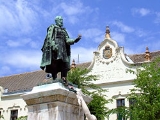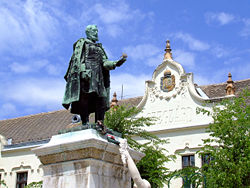
János Garay
Encyclopedia

Hungary
Hungary , officially the Republic of Hungary , is a landlocked country in Central Europe. It is situated in the Carpathian Basin and is bordered by Slovakia to the north, Ukraine and Romania to the east, Serbia and Croatia to the south, Slovenia to the southwest and Austria to the west. The...
poet
Poet
A poet is a person who writes poetry. A poet's work can be literal, meaning that his work is derived from a specific event, or metaphorical, meaning that his work can take on many meanings and forms. Poets have existed since antiquity, in nearly all languages, and have produced works that vary...
and author, was born in Szekszárd
Szekszárd
Szekszárd is a city in Hungary and the capital of Tolna county. By population, Szekszárd is the smallest county capital in Hungary; by area, it is the second smallest -Location:...
, Tolna County. From 1823 to 1828 he studied at Pécs
Pécs
Pécs is the fifth largest city of Hungary, located on the slopes of the Mecsek mountains in the south-west of the country, close to its border with Croatia. It is the administrative and economical centre of Baranya county...
, and subsequently, in 1829, at the University of Pest. In 1834 he brought out an heroic poem, in hexameter
Hexameter
Hexameter is a metrical line of verse consisting of six feet. It was the standard epic metre in classical Greek and Latin literature, such as in the Iliad and Aeneid. Its use in other genres of composition include Horace's satires, and Ovid's Metamorphoses. According to Greek mythology, hexameter...
s, under the title Csatár. Garay was an energetic journalist
Journalist
A journalist collects and distributes news and other information. A journalist's work is referred to as journalism.A reporter is a type of journalist who researchs, writes, and reports on information to be presented in mass media, including print media , electronic media , and digital media A...
, and in 1838 he moved to Bratislava
Bratislava
Bratislava is the capital of Slovakia and, with a population of about 431,000, also the country's largest city. Bratislava is in southwestern Slovakia on both banks of the Danube River. Bordering Austria and Hungary, it is the only national capital that borders two independent countries.Bratislava...
, where he edited the political journal Hírnök (Herald). He returned to Pest in 1839, when he was elected a corresponding member of the Hungarian Academy of Sciences
Hungarian Academy of Sciences
The Hungarian Academy of Sciences is the most important and prestigious learned society of Hungary. Its seat is at the bank of the Danube in Budapest.-History:...
. In 1842 he was admitted into the Kisfaludy Society
Kisfaludy Society
The Kisfaludy Society was a literary society in Pest, founded in 1836 and named after Károly Kisfaludy, who had died in 1830. It held monthly meetings and was a major force in Hungarian literary life, giving prizes, funding the collection of folk songs, and sponsoring the publication of works like...
, of which he became second secretary.
Garay enriched Hungarian literature with numerous lyrical poems, ballads and tales. The first collection of his poems was published in Pest; and his prose tales appeared in 1845, under the title of Tollrajzok (Sketches with the Pen). His historical ballads and legends, styled Árpádok (Pest, 1847, 2nd ed. 1848), showed him to be a master in the art of ballad-writing. Some of his lyrical poems also are excellent, as, for example, Balatoni kagylók (Shells from the Balaton
Balaton
Balaton may refer to:* Lake Balaton in Hungary, the largest lake in central Europe* Balaton Principality , a Slavic state* Balaton , a Hungarian microcar* Balaton, Minnesota, a city in the United States* 2242 Balaton, a main-belt asteroid...
Lake) (Pest, 1848). His legend Bosnyák Zsófia (Pest, 1847), and his poetical romance Frangepán Kristófné (Christopher Frangepan's Wife) (Pest, 1846), gained the prize of the Kisfaludy Society. His last and most famous work was an historical poem in twelve cantos, with the title Szent László (Saint Ladislaus) (Eger, 1852, 2nd ed., Pest, 1853, 3rd ed. 1863). Garay was professor of Hungarian language and literature to the University of Pest in 1848-1849. Since he was frail he supported the 1848 Revolution for freedom through his poetry. When the Revolutionaries lost he was condemned by the Habsburgs. After about four years illness he died in 1853, in great want. A collective edition of his poems was published in Pest the year after his death by F. Ney (2nd ed. 1860), and several of his poems were translated by Kertbeny
Karl-Maria Kertbeny
Karl-Maria Kertbeny or Károly Mária Kertbeny was an Austrian-born Hungarian journalist, memoirist, and human rights campaigner...
. His birthplace of Szekszárd has a statue to honor him.

